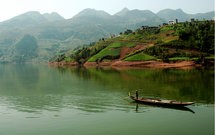 This is the third piece in a three-part series on the geopolitical implications of China's move to transform the Yangtze River into a major internal economic corridor. Part one provides a broad overview of the geography and history of the Yangtze River region and its role in shaping Chinese politics and statecraft. Part two examines the strategic river city of Wuhan, and part three considers the political economy of Beijing's push to develop the Yangtze River corridor.
This is the third piece in a three-part series on the geopolitical implications of China's move to transform the Yangtze River into a major internal economic corridor. Part one provides a broad overview of the geography and history of the Yangtze River region and its role in shaping Chinese politics and statecraft. Part two examines the strategic river city of Wuhan, and part three considers the political economy of Beijing's push to develop the Yangtze River corridor.
Beijing pursues far-reaching development programs such as the industrialization of the Yangtze River region not always because they make economic sense -- often they do not -- but because it must do so to sustain the basic social and economic structures that secure the regime. In the case of Yangtze development, an official from China's National Development and Reform Commission noted in May 2011 a shift in the focus of central government port development policy from the coast to the interior, adding that most of the opportunities for future port-related investment would be in cities along the Yangtze River. According to a statement earlier that year from the Ministry of Transport, as much as 200 billion yuan ($32 billion) would be invested in inland waterway port expansion during the 12th Five Year Plan (2011-2015), roughly double the amount set aside between 2006 and 2010. Wuhan's 10-year port redevelopment program is set to consume a large percentage of that investment -- at $28.6 billion, the program accounts for around 70 percent of the country's total ongoing and planned port construction -- though another $4 billion to $5 billion has been set aside for dredging and port expansion everywhere from Chongqing municipality in southwest China to Wuhu in Anhui province.
The central government's heightened emphasis on inland waterway port expansion is incongruous with port throughput trends during the previous five-year period, 2007-2011. Not surprisingly, China's coastal ports dwarf inland ports in terms of both overall throughput and throughput growth. But more telling is that of the major Yangtze ports for which the National Bureau of Statistics provides freight traffic data, only three (at Chongqing, Yueyang and Wuhu) showed significant growth in throughput between 2007 and 2011. Wuhan, the flagship of new port investment on the Yangtze as well as nationally, actually saw declines in both the number of berths and freight throughput during that period.
The apparent gap between central government policy prerogatives and the reality of port traffic growth trends exemplifies the way economic development policy under the Communist Party not only responds to present needs but also in many ways actively shapes future realities. In the case of Yangtze River port development, and especially the massive expansion of Wuhan's port networks, it is difficult to differentiate investment and construction to meet growing real demand from investment to direct future attention and activity where it otherwise may not have gone.
The distinction is subtle but important because it points to the fundamentally political nature of Yangtze River development efforts (and, more generally, development of the Chinese interior). The politics of inland development plays out on multiple levels, from granular politicking among cities and provinces for central government favor to the underlying forces and constraints that make processes like Yangtze River economic development a social and political necessity for Beijing.
Going forward, the question for Beijing will be whether and to what extent it is able to realize its ambitious plans for the Yangtze River corridor and inland China as a whole. Even then, it is not clear that expanding and industrializing a handful of inland cities will reduce mounting economic imbalances or social tensions unless combined with significant changes to a range of other policies, including the hukou (or household registration) system and the fiscal and financial relationship between city, provincial and national governments. Significant changes to these policies will, in turn, meet steep resistance from entrenched bureaucratic interests. More fundamentally, such changes would likely unleash the social unrest that Beijing's entire political economic system is intended to manage.
To the extent that inland port development is important for China's social and economic structures, port development in Wuhan is similar to projects like the Three Gorges Dam or the ongoing South-North Water Transfer Project, which seeks to divert up to 10 percent of the Yangtze River's flow to water-starved provinces in northern China. All three are attempts to reconcile immense geographic and environmental constraints with the ballooning demands (both consumer and industrial) of an enormous population and an ever-expanding economy -- all while providing enough jobs to maintain a degree of stability.
The problem, then, is not simply that the Chinese government's approach to economic development is inconsistent with the needs of the economy and population as a whole (though, depending on how those needs are defined, it may be). Rather, it is that the needs of the economy -- growth with stability, and energy security despite energy demands that far outstrip domestic resources -- are themselves inconsistent and contradictory. This by no means guarantees that Beijing's continual intervention in and efforts to directly manage Chinese economy and society will succeed, but it does help explain why the Communist Party -- and arguably, any government that attempts to rule China today -- intervenes in the first place.
Courtesy : Stratfor (www.stratfor.com)